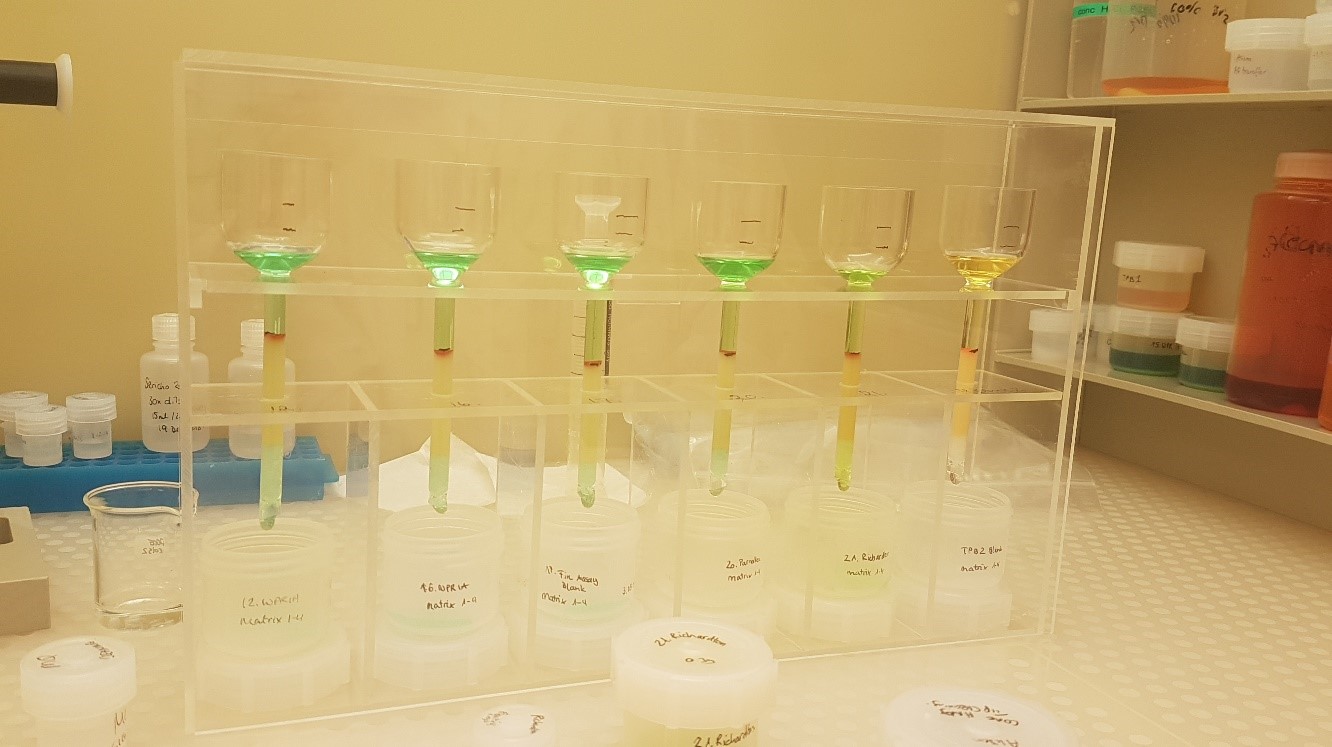Master's and Bachelor's theses
Contents
Hafnium isotopic constraints on sources of HIMU isotopic signatures in Isla Isabel, Mexico
Leonie Sieger (2022)
The volcanic islands of Guadalupe, Bárcena, Socorro, and Isabel offer a rare look into oceanic mantle that has otherwise escaped melting at mid-ocean ridges. Few of these oceanic intraplate-type islands have been thoroughly geochemically studied. Available geochemical constraints for Isla Isabel indicate that it displays influence from a HIMU-type reservoir (high-μ: high time-integrated 238U/204Pb) that is otherwise uncommon among mid-ocean ridge basalts (MORB). This project utilized basaltic samples from Isla Isabel and included the collection of new Nd, Hf, and Pb isotopic data to differentiate between hypotheses regarding the origins of HIMU-type volcanism. Although Isla Isabel is shown to have only modestly elevated 206Pb/204Pb ratios that are not as extreme as classical HIMU ocean island basalts (OIB), its Nd-Hf isotopic composition is similar to HIMU OIB. The mantle source of Isla Isabel is interpreted to record an ancient metasomatism event that greatly lowered its Lu/Hf ratio but only modestly increased its U/Pb ratio. Constraints from Hf isotopes imply that this event must have occurred at least 600 Ma in the past, which is much older than the nearby Middle America Trench. Instead, the HIMU signatures in the Isla Isabel source may be related to the breakup of the supercontinent Rodinia, evidence for which is normally absent in this region.
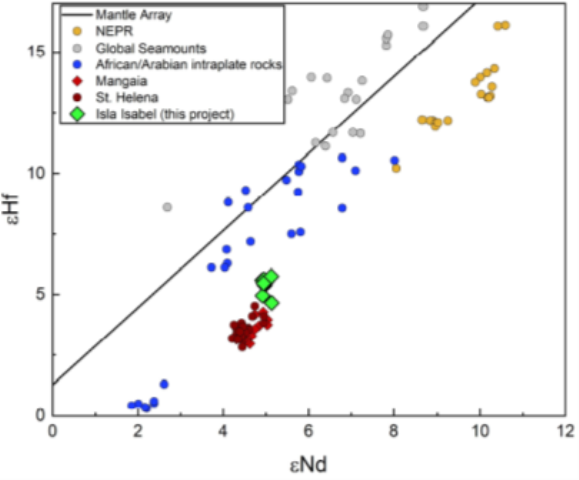
Figure. Neodymium and hafnium isotopic compositions (expressed as ε, parts per 104 deviation from a model for the bulk Earth) for Isla Isabel basalts (green diamonds) compared to regional mid-ocean ridge basalts (yellow circles), other global intraplate basalts (gray and blue circles) and classical HIMU-type ocean island basalts (red diamonds and dark red circles). Isla Isabel shows low ε176Hf, similar to classical HIMU-type localities.
Almahata Sitta: a genetic investigation of a polymict breccia using chromium nucleosynthetic compositions
Romain Alosius (2021)
The meteorite fall Almahata Sitta is classified as an anomalous polymict breccia and includes fragments of both non-carbonaceous (NC) and carbonaceous chondrite (CC)-like material. However, the NC and CC reservoirs are theorised to have been spatially or temporally separated when they formed. Nucleosynthetic isotope variations are powerful tools to track genetic relationships between solar system objects. Variations of Cr isotopes in solar system materials are widespread and well-characterized. Therefore, measuring the Cr isotope composition of Almahata Sitta meteorite fragments can give us useful information on the origin of the observed lithologies. To do so, fragments of the Almahata Sitta collection were prepared for Cr isotope measurements. The preliminary ε54Cr results obtained are consistent with the petrological classification of these fragments and the expected ranges given by the literature.
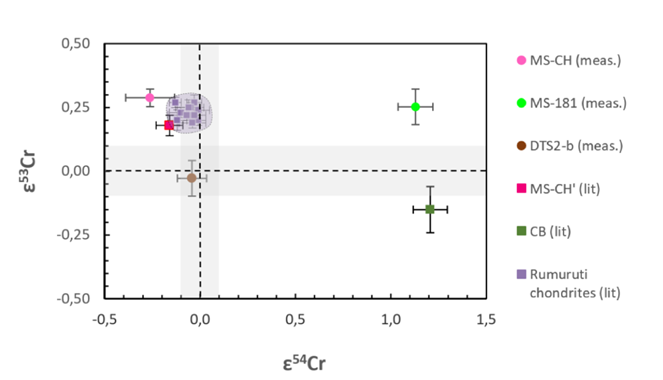
Figure: ε53Cr vs. ε54Cr for Almahatta Sitta samples MS-CH and MS-181, compared to the literature averages for CB and Rumuruti chondrites (Shukolyukov and Lugmair, 2006, Zhu et al., 2021). MS-CH’ represents a separate fraction of the sample measured by Zhu et al. (2021). DTS2-b is a terrestrial dunite rock standard. The error bars for the CB average are 2SD, as opposed to the 2SE given for the values measured in this thesis, the values for Rumuruti chondrites and MS-CH’. The grey bars represent uncertainties based on terrestrial samples.
Understanding Silver Isotope Fractionation in the Epithermal Environment: A Case Study in the District of Freiberg, Germany
Leila Iseli (2021)
The fractionation of metal isotopes provide important tools to trace a large variety of geological processes. The silver isotope composition of ore minerals may be used to better understand hydrothermal ore formation. However, the processes that cause silver isotope fractionation have to be better understood. For this, samples from the hydrothermal vein-style mineralization of the district of Freiberg (Germany) were studied in this project: Different silver-rich minerals were separated, characterized and measured for their silver isotope composition.
This project was co-supervised with the Mineral Resource Systems and Ore Fluids research group https://erdw.ethz.ch/en/research/institutes/geochemistry-petrology/fluid-processes-mineral-resources.html
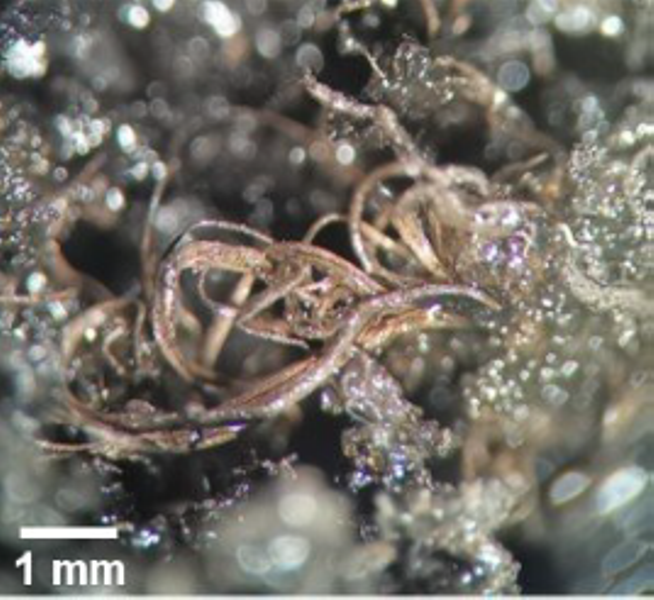
Figure caption: Native silver sample.
Evaluating recent and ancient contributions to the Réunion volcanic hotspot using isotopic and trace element compositions
Marc Halfar (2020)
The volcanic hotspot La Réunion and its neighboring islands provide one of Earth’s most pristine records of its deep interior and its primordial past. For example, the Réunion mantle plume may have disturbed a fragment of 3-billion-year-old continental crust that was left behind during the rifting of the supercontinent Gondwana, and may also actively interact with the Central Indian Ridge (CIR) over a distance of more than 600 kilometers. This project utilized Sr, Nd, and Pb isotopic compositions to constrain the influence of these various sources on Réunion’s neighboring islands, Mauritius and Rodrigues. The isotopic data provide strong support for geochemical interaction between the mantle plume and the CIR in Rodrigues and to a lesser extent in Mauritius. On the other hand, Pb isotopic data are inconsistent with direct interaction between the mantle plume and continental crust. Despite this, it was unexpectedly revealed that Rodrigues is the only island in the Mascarene chain that preserves isotopic evidence for long-term recycling of continental sediments, a phenomenon that has been observed for other global hotspots but not yet for Réunion.
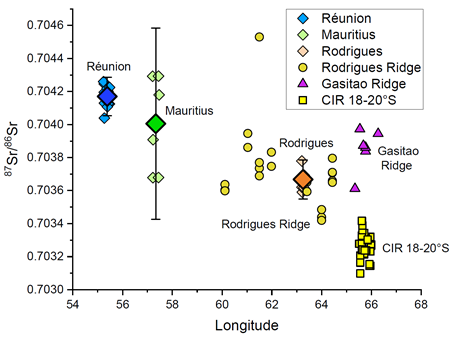
Figure. Strontium isotopic compositions of Réunion, Mauritius, and Rodrigues OIB (this project and published data) along with other seafloor structures and the Central Indian Ridge (published data and unpublished Ph.D. thesis data). The Sr isotopic compositions show a trend between a relatively radiogenic composition in the Réunion source and the isotopically depleted source of CIR mid-ocean ridge basalts. This trend is strong evidence that material from the Réunion plume mixes with CIR-derived material in the region around Rodrigues Island and the Rodrigues Ridge.
Origins of Nucleosynthetic Iron Isotope Variations in Iron Meteorites
Courtney Rundhaug (2021)
Iron meteorites come from the cores of early-formed asteroids and can therefore shed light on processes including early solar system mixing. Isotope ratios measured for the element Fe show variations between iron meteorite groups. These may be nucleosynthetic in origin, and therefore inherited from presolar dust that retains the composition of the star it formed around. This dust is then heterogeneously mixed through the early solar system. However, iron meteorites are also affected by galactic cosmic rays (GCR) while traveling through space, and this irradiation alters their original isotopic composition. Platinum isotopes are an established ‘dosimeter’ to correct for this effect. In this thesis we explored the causes of the measured variations in iron meteorites by comparing Fe isotope data to Pt.
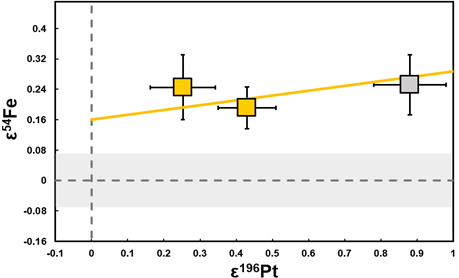
Figure. ε54Fe vs. ε196Pt for the IVB iron meteorites. Data collected in this study are the yellow symbols, and literature data (Schiller et al. 2020) are in grey. The yellow line represents a trend-line through the samples, and the intercept with the y-axis shows the pre-GCR ε54Fe. The grey bars represent the analytical uncertainty of Canyon Diablo for a single measurement session.
Computed tomography as a non-destructive chondrule analysis tool: Capabilities, limitations, and application to single CR chondrule titanium isotope analysis data.
Noah Jäggi (2018)
Chondrules are crystallised droplets of silicate melt that formed by rapid heating in the solar nebula. They are a main component in most chondrites, which represent the most primitive objects known in our solar system. Computed Tomography (CT) and nucleosynthetic Ti isotope analyses of single chondrules were carried out to obtain constraints on the chondrule formation process(es). The data also provide information about transport and mixing processes in the solar nebula. Nucleosynthetic Ti isotope compositions of CR chondrules are distinct, suggesting that CR chondrules formed in a specific region of the solar nebula. Moreover, the Ti isotope data of two chondrules from the Shişr 033 meteorite indicated major dust transport in the solar nebula.
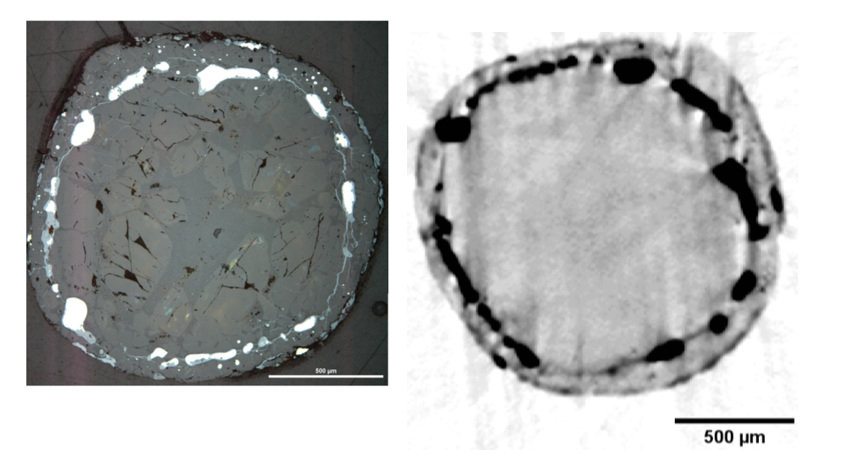
Learn more about our research
Formation of the Solar System and the planetsThe protoplanetary disc origins of CB chondrites and their components assessed using Fe isotopes
Céline Graber (2022)
CB chondrites are unique mixtures of metal and silicate chondrules that are thought to be formed through collisional processes. However, it is currently unknown whether the metal and silicate originated on the same asteroid, or whether the impactor contributed one of these two phases. We tested this using Fe isotopes, that are known to have variations between different meteorite groups. Metal and silicate portions were digested and analysed separately and used to further constrain models of CB formation processes.
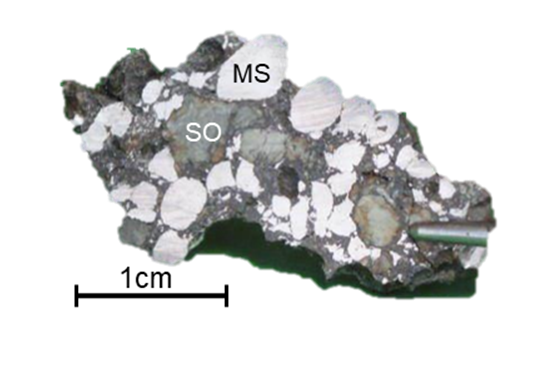
Figure: Sample GUJ3-28 from the Gujba meteorite. It includes skeletal olivine (SO) and Fe,Ni-sulfide (MS) chondrules and dark silicate-rich matrix. Photograph from I. Ivanov-Bucher.
Assessing platinum group element concentrations and the effects of galactic cosmic rays in chondrite meteorites.
Leonie Sieger (2020)
Galactic cosmic rays (GCR) alter some isotope ratios as a meteorite travels through space. Platinum isotopes in some iron meteorites are strongly affected by neutron capture reactions caused by GCR. This is due to their long travel times, but also because higher Ir/Pt ratios lead to larger effects on 192Pt. However, chondrite meteorites have much shorter travel times in space, and it is often assumed that they are unaffected by GCR. This project reassessed Pt isotope data for ordinary chondrite meteorites and compared them to GCR models to determine whether neutron capture needs to be corrected in chondrites.
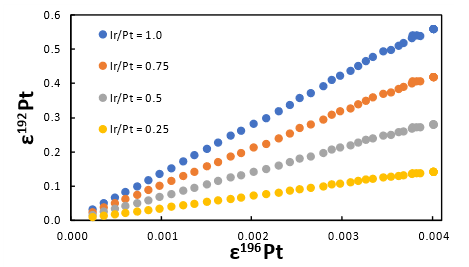
Figure: ε192Pt vs ε196Pt with four different Ir/Pt ratios. The graph shows the influence of Ir/Pt ratios on a typical ordinary chondrite with a radius of 40 cm and an exposure age of 7 Ma. The GCR model is from Leya and Masarik (2013).
Measurements of nucleosynthetic chromium isotope anomalies in meteorites
Romain Alosius (2019)
The study of meteorites is a cornerstone of cosmochemistry. The isotopic compositions of meteorites are controlled by different processes: (i) mass-dependent fractionation due to chemical and physical reactions and (ii) mass-independent fractionation that results from either radioactive decay, galactic cosmic ray irradiation in space, or nucleosynthetic processes that took place in previous generations of stars. Presolar dust preserves a record of nucleosynthesis. Nucleosynthetic variations result from a heterogeneous distribution of presolar dust in the solar system. They exist between different meteorite groups and the Earth. These widespread variations can be used to trace genetic relationships between solar system objects. In this project, ultraprecise Cr isotope compositions were determined for 8 meteorites and combined with nucleosynthetic Ti isotope data to trace their parent bodies.
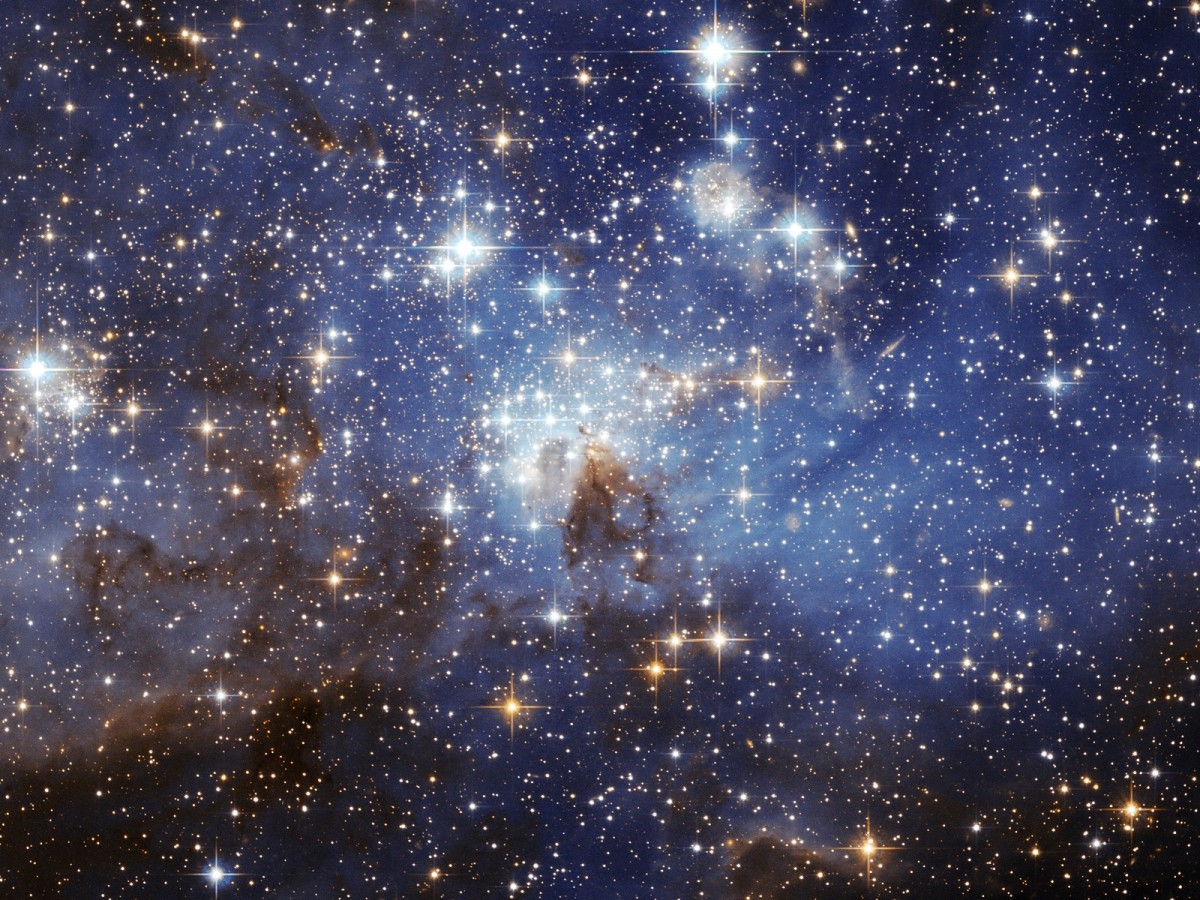
Does the heterogeneity of a meteorite at milligram scale affect the determination of cosmic ray exposure ages?
Maria Di Gregorio (2018)
Cosmic ray exposure (CRE) in space produces cosmogenic noble gases including 3He and 38Ar. These can be used to calculate a CRE age, i.e., how long a meteorite travelled from its parent body to the Earth. However, discrepancies are often observed between CRE ages from the same meteorite. We examined the effect of chemical heterogeneity on cosmogenic noble gas concentrations in the LL/L5 chondrite Knyahinya. Both noble gas and major element compositions of multiple small aliquots of Knyahinya were measured. The concentrations of the major elements vary significantly from sample to sample and correlate with 38Arcosm. This study demonstrates that it is essential to measure both element concentrations and 38Arcosm in the same sample aliquot to understand 38Ar CRE ages.
Project together with the noble gas cosmo- and geochemistry group
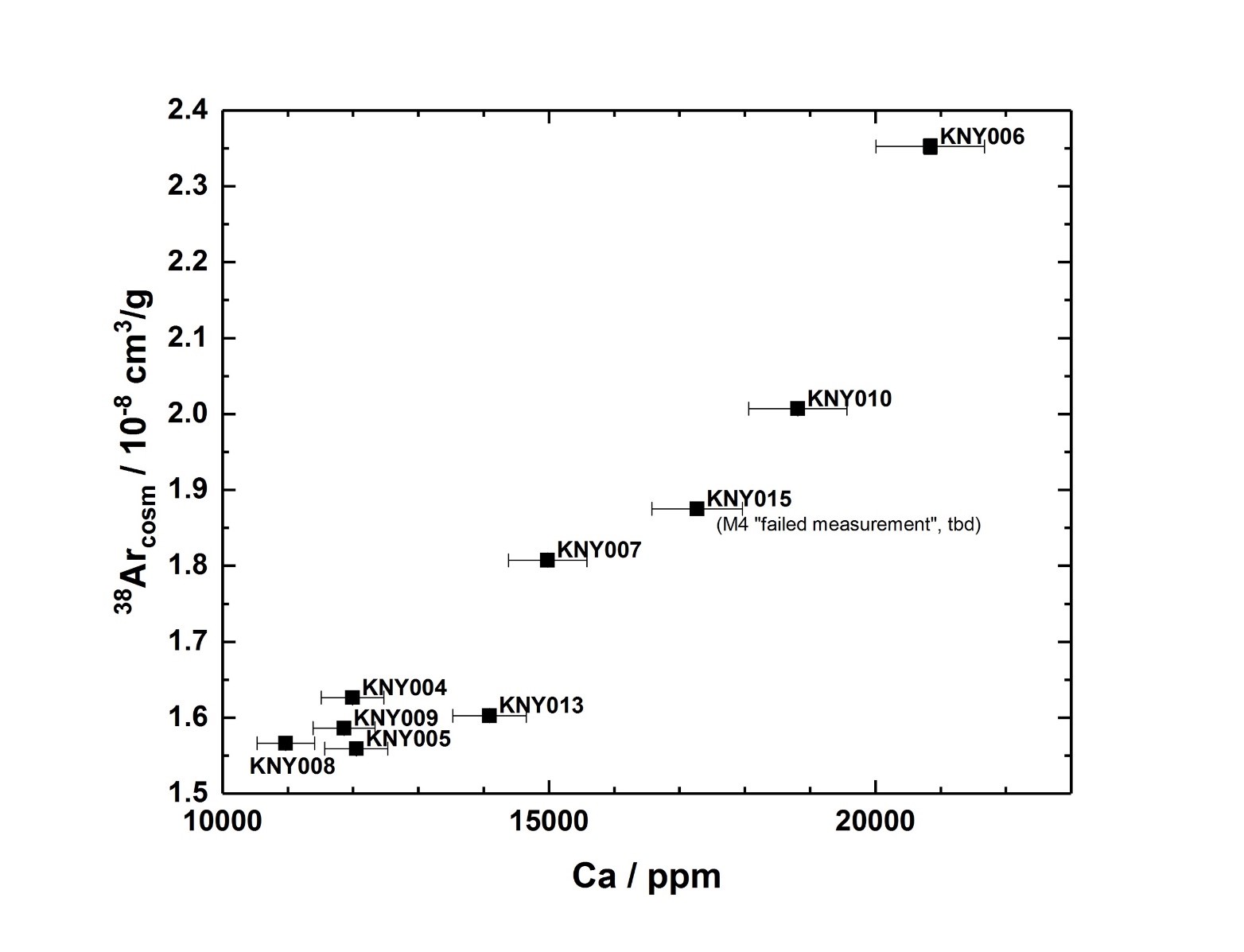
Do the ordinary chondrites show variations in Pt isotope ratios? Assessing the effects of galactic cosmic rays and nucleosynthetic variations.
Leila Iseli (2018)
Galactic cosmic rays (GCR) alter some isotope ratios as a meteorite travels through space. Platinum is susceptible to GCR, and studies of iron meteorites have shown that Pt isotopes are a good GCR dosimeter. This implies that Pt can be used to correct for the effects of GCR in other isotope systems, e.g., W, which is part of the useful short-lived chronometer 182Hf → 182W. Iron meteorites have long exposure times in space and show large GCR effects, but chondrite meteorites have much shorter exposure times. This project examined to what extent chondrite meteorites are affected by GCR by measuring Pt isotopes.
